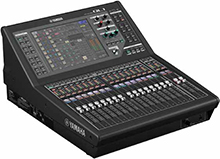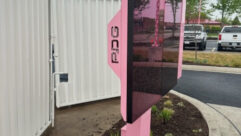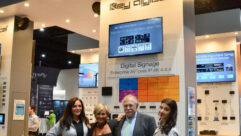

While most major manufacturers continue to offer analog consoles, it’s quite clear we traversed the equilibrium curve some time ago, and now most manufacturers are devoting most of their resources to the development of digital mixers.
It’s a wonder that analog consoles still exist, so numerous are the advantages of digital. The digital mixer has now reached a level of maturity that facilitates (or necessitates, if you’re not fond of it) a stratification of the market in order to enable the targeting of marketing efforts. Very few manufacturers offer a line of digital consoles across the entire spectrum from consumer to high-end professional. Yamaha is one that does, and its price range of digital mixers starts with the sub-$3,000 01V96i and reaches its apex with the $70,000 PM5D. The 32-input QL-1 console sent to me for evaluation lands at the fourth-from-the-top level in terms of price and capabilities. This means that it has some powerful capabilities that put it head and shoulders above the best offerings of some manufacturers, but other makers offer mixers that surpass this unit’s capacities considerably, albeit with higher price tags, substantially so in some cases. I assessed this console and reached the conclusion that it is a great value, and able to serve an appreciably broad range of applications.
There are two versions of the QL series available, or rather two sizes; the QL5, with 32 analog inputs and 16 analog “omni” outputs, and the QL1, with 16 analog ins and eight omni outs. Both offer digital I/O, giving the consoles the capacity for more mix channels than analog I/O would suggest, 64 mono/eight stereo in the case of the QL5, and 32 mono/ eight stereo in the case of the QL-1. Otherwise, the two models are operationally the same. The Dante interface built into these consoles yields matrix routing—64×64 in the QL5 and 32×32 in the QL1. The mix channel count is impressive to me, seemingly more so in the case of the QL1 I evaluated, because its physical footprint is quite small. So it feels like a lot of channels packed in. There are 16 auxiliaries and eight matrix sends per channel, and 16 DCAs to which channels may be assigned. Each channel strip features an input gain section, which allows cross-patching from the physical inputs, two dynamics processors, panning, delay, a high-pass filter, and four bands of equalization (low and high filters can be switched to shelving). The mixer features both stereo and mono master faders. Beyond the aforementioned analog XLR and Dante I/O, the console also offers an AES/EBU output and two slots facilitating I/O via mini-YGDAI cards, along with control I/O for MIDI, GPI, Ethernet, and word clock, as well.
The physical QL1 console is startlingly small, considering the horsepower it delivers. The lower segment features the mixer’s 16 channel faders, divided into two sections of eight each, along with the two master faders. Above each channel fader is a user-changeable color strip with nine options to indicate control function. Above this strip is an LCD scribble strip, followed by an on/off pushbutton, a six-segment LED level meter, a cue button, and finally a select button. These displays are all very clear and well-illuminated—no mistaking what’s being displayed. Above the fader section the surface tilts upward, directing the display toward the eyes of the user. At the left edge of this surface are found the mixer’s 16 “sends on fader” buttons, facilitating very quick access to any of 16 monitor mixes and eight matrix sends. I really like this feature. No frantic menu dive trying to get to the right page as an impatient musician demands a tweak. One button push and bang—you’re there. At the right edge are 12 user-defined buttons, four fader bank selection buttons, and atop all that a USB jack allowing connection of an external thumb drive for 2-track recording/playback, as well as loading and saving files to/from the console. To the left of these controls are knobs representing the channel strip controls; gain, pan, threshold level for both dynamics processors, HPF cutoff frequency, and center frequency, Q, and gain for the channel’s EQ. There also are four buttons to select which of the four EQ bands is affected by the three knobs. There is a master “touch and turn” knob, which controls whichever parameter is currently selected on the mixer’s touchscreen, which dominates the middle of the upper control surface. It’s a very bright, very clear photo-realistic display showing virtually every parameter of the console, selectable by touching the screen. One minor complaint here—I really had to apply a substantial amount of pressure to get the touchscreen to react, and I could not find a sensitivity adjustment in the mixer’s system menu.
Among the most notable features that distinguish this mixer from its competitors is its internal virtual rack, which delivers a couple of important and desirable advantages. First, among the plug-ins that ship from the manufacturer are high-quality premium effects, some developed in conjunction with legendary designer Rupert Neve. To fill a hardware rack with the equivalent compliment of physical processors would be prohibitive in terms of price, to say the least. Second, virtual effects weigh virtually nothing. Their hardware counterparts contribute to the retirement funds of many a chiropractor. Aside from these benefits, these high-quality processors, which sound very good, are vastly easier to use and create capabilities that simply don’t exist in the real world. In all my professional life, I’ve never decided, in the middle of mixing a show, to physically install into my rack an additional two-bus compressor, patch it in, and use it to get a little more punch out of my mix. But I can do that here, and it’s incredible, because it opens up a world of possibilities. Another powerful distinguishing factor in the QL1 is the inclusion of Dan Dugan’s renowned automatic mic-mixing technology, which can be a powerful tool for engineers in applications requiring a multitude of open mics, such as conferences or broadcast. The internal Dugan can be used in either an 8-channel or 16-channel configuration.
Console manufacturers have seen the writing on the wall, and it seems as if they are all scrambling to implement means by which their devices can be controlled remotely by smart devices, the Apple iPad and iPhone, in particular. Yamaha is no exception, and the QL1 mixer can indeed be controlled by a computer app known as QL Editor, and by extension, an iPad. This facilitates control over quite a lot of the parameters of the console, which makes it very useful, and hence a very welcome feature. One complaint in this domain; the mixer can only be controlled by a single iPad at a time, which precludes the possibility of allowing musicians to engage in “more me” control of their own monitor mixes. I would guess that Yamaha will eventually make that feature happen.
The Yamaha QL1 Digital Mixing Console is physically very small—so small in fact that it can be rack mounted. But despite its size, it packs a wallop: it features ample built-in I/O, extremely flexible signal routing, more-than-sufficient auxiliaries, excellent perchannel processing, an exceptional user interface (including remote computer and smart device control), and world-class premium signal processing built in. Yamaha uses the term “natural sound” copiously throughout its promotional materials for the console, and they’ve earned the right to do so. I was very happy with the transparent nature of the signal path, input to output, and equally thrilled with what I was able to do to sculpt and improve that signal with the system’s processing. The console delivers a lot of value and startlingly high performance, and its pricing will make it available to a much broader range of potential customers than consoles of this quality have been before. It may even occupy some of the sweet spot in which it provides the level of quality expected from the next price range above it, making its appeal even broader. Yamaha has quite a lot to be pleased with in the QL1.
John McJunkin is the principal of Avalon Podcasting in Chandler, Ariz., and produces and cohosts a top-rated radio talk show in Phoenix. He has consulted in the development of studios and installations and provides high-quality podcast and voice production services.
PRODUCT SUMMARY
COMPANY: Yamaha Corporation of America | www.yamahaproaudio.com
PRODUCT: Yamaha QL-1 Digital Mixing Console
PROS: Substantial processing horsepower, customizable interface, remote iPad control
CONS: Touchscreen requires substantial pressure, can only accept input from one iPad at a time
APPLICATIONS: A/V, corporate, touring, rental, house of worship
PRICE: $8,499
SPECIFICATIONS
SAMPLING FREQUENCY: 44.1kHz/48kHz
SIGNAL DELAYS: Less than 2.5ms, input to omni out (Fs=48kHz)
FADERS: 100mm motorized, resolution=1024 steps, +10dB to -138dB
FREQUENCY RESPONSE: 20Hz-20kHz, +0.5dB, -1.5dB (refer to +4dBu output @1kHz, input to omni out)
TOTAL HARMONIC DISTORTION: Less than 0.05%, 20Hz-20kHz, @+4dBu into 600Ω, input to omni out, input gain=minimum)
HUM & NOISE (A-WEIGHTED): -128dBu typ., EIN, input gain=max., -88dBu, residual output noise, ST master off
DYNAMIC RANGE: 112dB typ., converter, 108dB typ., input to omni out channels, input gain=min.
CROSSTALK (@ 1KHZ): -100dB, adjacent input/omni out channels, input gain= min.










